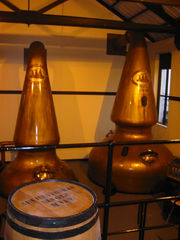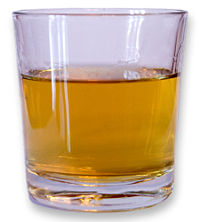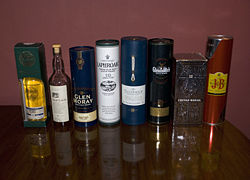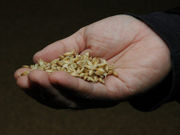Whisky
2008/9 Schools Wikipedia Selection. Related subjects: Drink
Whisky ( Scottish Gaelic: uisge-beatha), or whiskey ( Irish: uisce beatha or fuisce), refers to a broad category of alcoholic beverages that are distilled from fermented grain mash and aged in wooden casks (generally oak).
Different grains are used for different varieties, including: barley, malted barley, rye, malted rye, wheat, and maize (corn). Whisky derives from the Gaelic word for "water" (uisce or uisge), and is called in full uisge-beatha (in Scotland) or uisce beatha (Ireland), meaning "Water of Life". It is related to the Latin aqua vitae, also meaning "water of life". It is always Scotch whisky, and Irish whiskey.
The first written record of whisky comes from 1405 in Ireland, where it was distilled by monks. It is also mentioned in Scotland in 1496. However it is thought that whisky had already been around for at least several hundred years prior. When or where whisky was first distilled is unknown and the local, undocumented beverage production during the period makes identification of the drink's origin difficult. Additionally, it is possible that different groups discovered processes of distillation completely independently of one another.
Some scholars believe distilled spirits were first produced between the 8th century AD and 9th century AD in the Middle East with the art of distillation being brought to Ireland and Britain by Christian monks. A popular legend is that St. Patrick introduced distillation to Ireland and Britain, however it is likely he lived around the 5th century AD. It is also possible that the distillation process was discovered in Ireland and possibly Britain (either independently or in precursor to Arabian distillation) by farmers as a way of making use of excess grain after harvest.
Types of whisky

Whisky or whisky-like products are produced in most grain-growing areas. They differ in base product, alcoholic content, and quality.
Scotch whiskies
Scotch whiskies are generally distilled twice, though some are distilled a third time. International laws require anything bearing the label "Scotch" to be distilled in Scotland and matured for a minimum of three years in oak casks. Whiskies do not mature in the bottle, only in the cask, so the "age" of a scotch is the time between distillation and bottling. This reflects how much the cask has interacted with the whisky, changing its chemical makeup and taste. Whiskies which have been in bottle for many years may have a rarity value, but are not "older" and will not necessarily be "better" than a more recently made whisky matured in wood for a similar time. If Scotch whisky is from more than one cask, and if it includes an age statement on the bottle, it must reflect the age of the youngest whisky in the blend. Many cask-strength single malts omit the age as they use younger elements in minute amounts for flavouring and mellowing. The two basic types of Scotch are Malt and Grain.
- Malt is whisky made entirely from malted barley and distilled in an onion-shaped pot still.
- Grain is made from malted and unmalted barley along with other grains, usually in a continuous "patent" or "Coffey" still. Until recently it was only used in blends—but there are now some "Single Grain" scotches being marketed.
- Malts and Grains are combined in various ways
- Vatted malt is blended from malt whiskies from different distilleries. If a whisky is labelled "pure malt" or just "malt" it is almost certain to be a vatted whisky. This is also sometimes labelled as "Blended Malt" whisky.
- Single malt whisky is malt whisky from a single distillery. However, unless the whisky is described as "single-cask" it will contain whisky from many casks, so the blender can achieve a taste recognisable as typical of the distillery. In most cases, the name of a single malt will be that of the distillery ( The Glenlivet, Glenmorangie, Bowmore), with an age statement and perhaps some indication of some special treatments such as maturation in a port wine cask.
- Blended whiskies are normally cheaper whiskies made from a mixture of Malt and Grain whiskies. A whisky simply described as Scotch Whisky is most likely to be a blend in this sense. A blend is usually from many distilleries so that the blender can produce a flavour consistent with the brand, and the brand name (e.g. Bell's, Chivas Regal) will usually not therefore contain the name of a distillery. However, "Blend" can (less frequently) have other meanings. A mixture of malts (with no grain) from different distilleries (more usually called a vatted malt) may sometimes be referred to as a "Blended Malt", and a mixtures of grain whiskies with no malts will sometimes carry the designation "Blended Grain".
Irish whiskeys
Irish whiskeys are generally distilled three times and must be aged in wooden casks for a period of not less than three years. Unpeated malt is almost always used, the main exception being Connemara Peated Malt whiskey.
There are several types of whiskey common to Ireland: Single Malt, Single Grain, Pure Pot Still and Blended Whiskey. Pure pot still whiskey refers to Irish whiskey made from a combination of malted and unmalted barley and distilled in a pot still.
Japanese whiskies
Japanese whiskies generally fit within the Scotch tradition and can be categorised using the above typology. For some time it was believed by many that whisky made in the Scotch style, but not produced in Scotland, could not possibly measure up to the standards of the traditional Scotch distilleries. Because of this, until fairly recently, the market for Japanese whiskies was almost entirely domestic. However in recent blind tastings some Japanese whiskies have scored at least as well as many Scotch whiskies.
Canadian whiskies
Canadian whiskies have the regulatory requirement of being aged for at least three years in a barrel. Most Canadian whiskies are blended multi-grain whiskies and are usually lighter and smoother than other whiskey styles. These are also called " rye whisky" in Canada, though the American definition of "Rye Whiskey" prevents them from being so labelled in the USA.
American whiskeys
American whiskeys include both straights and blends. To be called "straight" the whiskey must be one of the "named types" listed in the federal regulations and aged in oak casks for at least two years. The most common of the "named types" are:
- Bourbon, which must be at least 51% corn (maize).
- Rye, which must be at least 51% rye.
- Corn, which is made from a mash made up of at least 80% corn (maize). The whiskey is distilled to not more than 80 percent alcohol by volume. It does not have to be aged but, if it is aged, it must be in new uncharred oak barrels or used barrels. Ageing usually is brief, i.e., six months. During ageing the whiskey picks up colour and flavour and its harshness is reduced.
All straight American whiskeys except straight corn whiskey must be aged in new casks that have been charred on their inside surface. American blended whiskeys combine straight whiskey with un-aged whiskey, grain neutral spirits, flavourings and colourings. These definitions are part of U.S. law. Not defined by the law but important in the marketplace is Tennessee whiskey, of which Jack Daniel's is the leading example. During distillation, it is identical to bourbon in almost every important respect. The most recognizable difference is that Tennessee whiskey is filtered through sugar maple charcoal, giving it a unique flavour and aroma.
Welsh whiskies
In 2000, Penderyn Distillery started production of the Penderyn single malt Welsh whisky in Wales. The first bottles went on sale on 1 March 2004, Saint David's Day. It is now sold throughout the world.
Indian whiskies
Indian whisky is an alcoholic beverage that is labelled as "whisky" in India. Much Indian whisky is distilled from fermented molasses, and as such would be considered a sort of rum outside of the Indian subcontinent. 90% of the "whisky" consumed in India is molasses based, although India has begun to distill whisky from malt and other grains.
Names and spellings
Whisky is an Anglicisation of the 17th century Irish uisce beatha (IPA: [ɪʃkʲə bʲahə]) meaning "water of life". The name itself may have originally derived from a Goidelic translation of the Latin phrase aqua vitae.
The spelling whisky (plural whiskies) is generally used for whiskies distilled in Scotland, Wales, Canada, and Japan, while whiskey is used for the spirits distilled in Ireland. A 1968 directive of the Bureau of Alcohol, Tobacco and Firearms specifies "whisky" as the official U.S. spelling, but allows labelling as "whiskey" in deference to tradition; most U.S. producers still use the latter spelling, Early Times, Maker's Mark, and George Dickel being among the few exceptions.
In the late Victorian era, Irish whiskey was the world's whiskey of choice. Of the Irish whiskeys, Dublin whiskeys were regarded as the grands crus of whiskeys. In order to differentiate Dublin whiskey from other whiskeys, the Dublin distilleries adopted the spelling "whiskey". The other Irish distilleries eventually followed suit. The last Irish "whisky" was Paddy, which adopted the "e" in 1966.
A mnemonic used to remember which spelling is used is that "Ireland" and "United States" have at least one "e" in their names, while "Scotland", "Canada" and "Japan" do not. Welsh and New Zealand whisky are exceptions to this rule.
In some countries, the abbreviated term " Scotch" is often used for " Scotch whisky".
Chemistry
Whiskies and other distilled beverages such as cognac and rum are complex beverages containing a vast range of flavouring compounds, of which some 200 to 300 can be easily detected by chemical analysis. The flavouring chemicals include " carbonyl compounds, alcohols, carboxylic acids and their esters, nitrogen- and sulphur-containing compounds, phenolic compounds, terpenes, and oxygen-containing heterocyclic compounds" and esters of fatty acids. The nitrogen compounds include pyridines, picolines and pyrazines.
Flavours from distillation
The flavouring of whisky is partially determined by the presence of congeners and fusel oils. Fusel oils are higher alcohols than ethanol, are mildly toxic, and have a strong, disagreeable smell and taste. An excess of fusel oils in whisky is considered a defect. A variety of methods are employed in the distillation process to remove unwanted fusel oils. Traditionally, American distillers focussed on secondary filtration using charcoal, gravel, sand, or linen to subtract undesired distillates. Canadian distillers have traditionally employed column stills which can be controlled to produce an almost pure (and less flavourful) ethanol known as neutral grain spirit or grain neutral spirit (GNS). Flavour is restored by blending the neutral grain spirits with flavouring whiskies.
Acetals are rapidly formed in distillates and a great many are found in distilled beverages, the most prominent being acetaldehyde diethyl acetal (1,1-diethoxyethane). Among whiskies the highest levels are associated with malt whisky. This acetal is a principle flavour compound in sherry, and contributes fruitiness to the aroma.
The diketone diacetyl (2,3-Butanedione) has a buttery aroma and is present in almost all distilled beverages. Whiskies and cognacs typically contain more than vodkas, but significantly less than rums or brandies.
Flavours from Oak
Whisky lactone (3-methyl-4-octanolide) is found in all types of oak. This lactone has a strong coconut aroma. Whisky lactone is also known as quercus lactone.
Commercially charred oaks are rich in phenolic compounds. One study discriminated 40 different phenolic compounds. The coumarin scopoletin is present in whisky, with the highest level reported in Bourbon.
Health effects
The health benefits of moderate alcohol consumption (better health and longevity) commonly associated with wine appear to apply also to whisky. Many researchers now suspect that the beneficial substance is the alcohol itself — although research has not ruled out other components in the beverages as also being responsible for beneficial effects. However, excessive consumption of alcohol can harm many of the body's essential organs, particularly the liver. Furthermore, frequent consumption of strong spirits, such as whisky, significantly increases a person's chance of developing head and neck cancers.
People once thought that whisky made from barley/malt contained gluten and should be avoided on a gluten-free diet, along with beers, lagers, ales and stouts. It is now known that the distillation process removes all traces of gluten and is safe to consume on a gluten-free diet.



